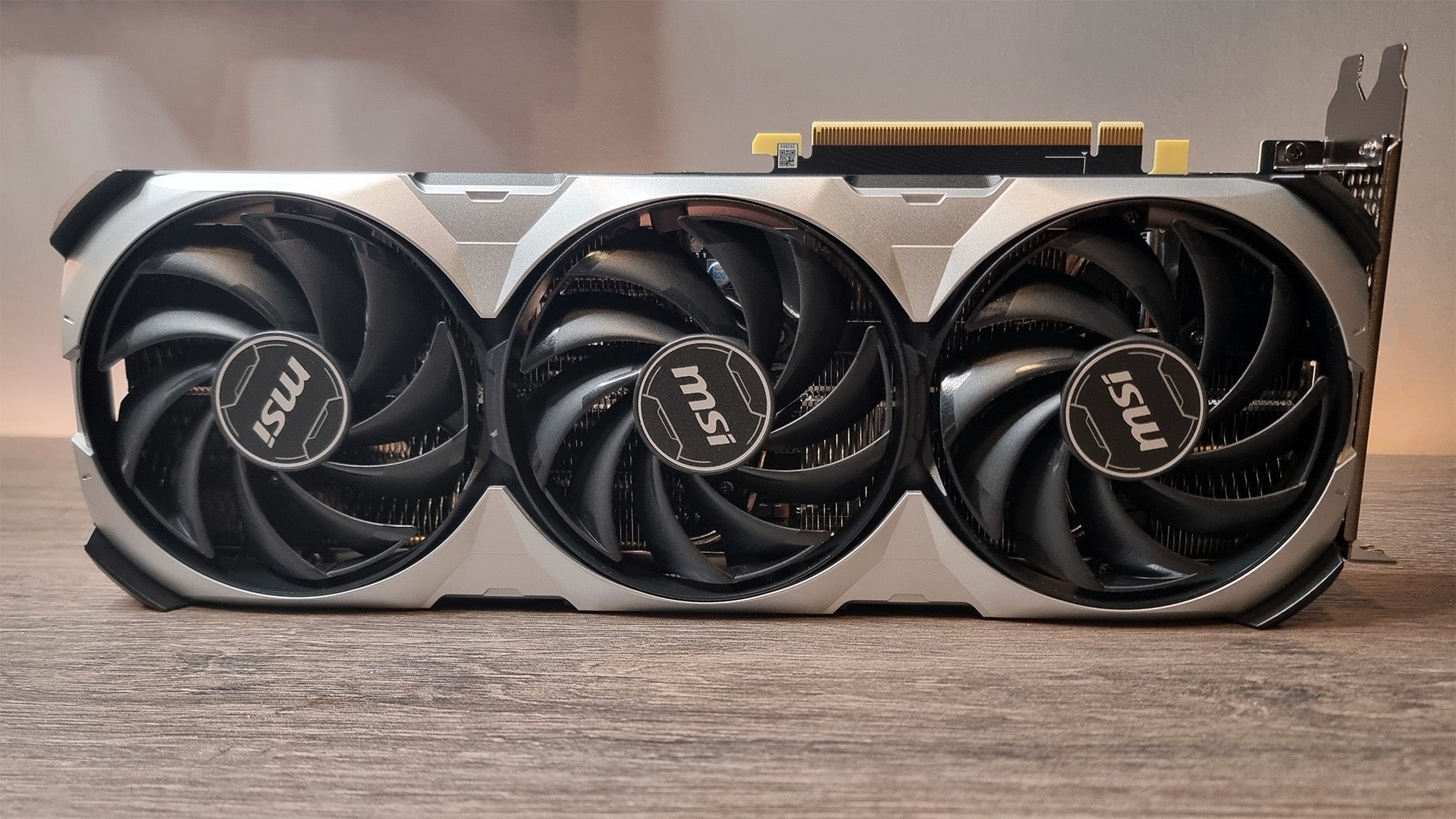Intel Arc A750 Review
The ultimate budget graphics card



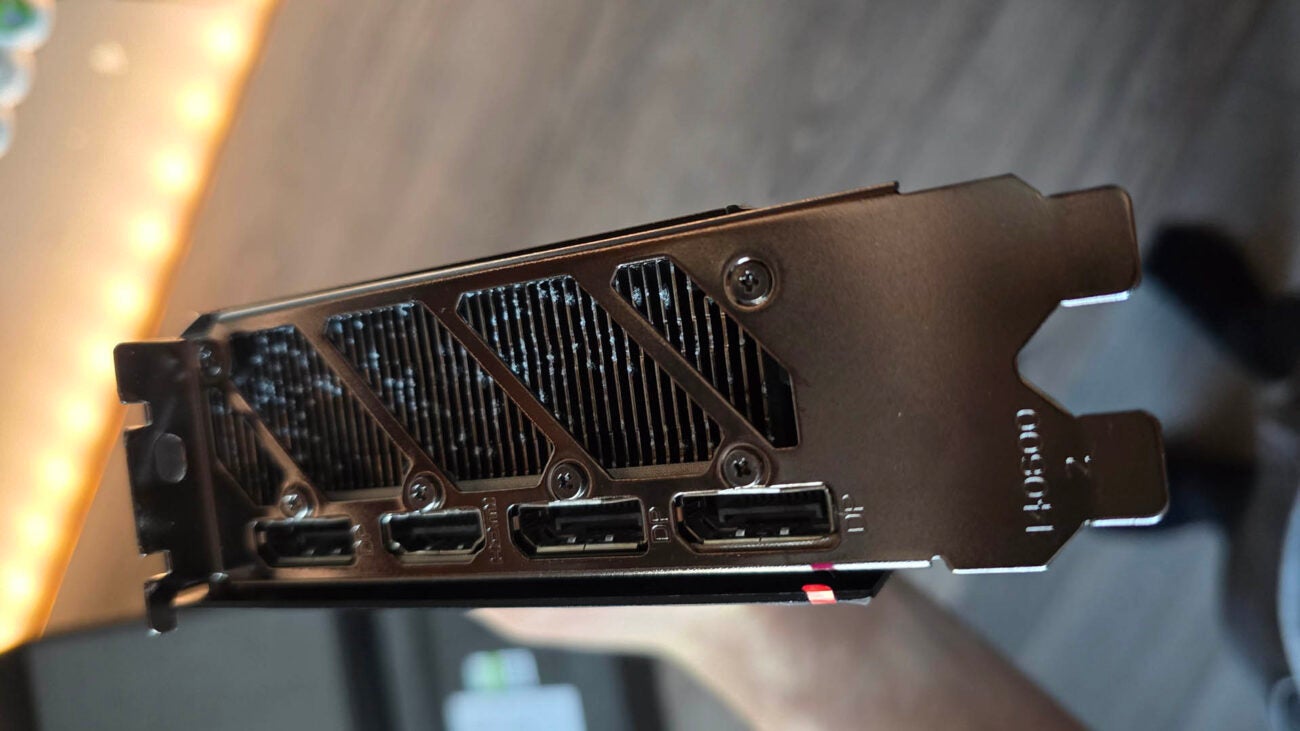
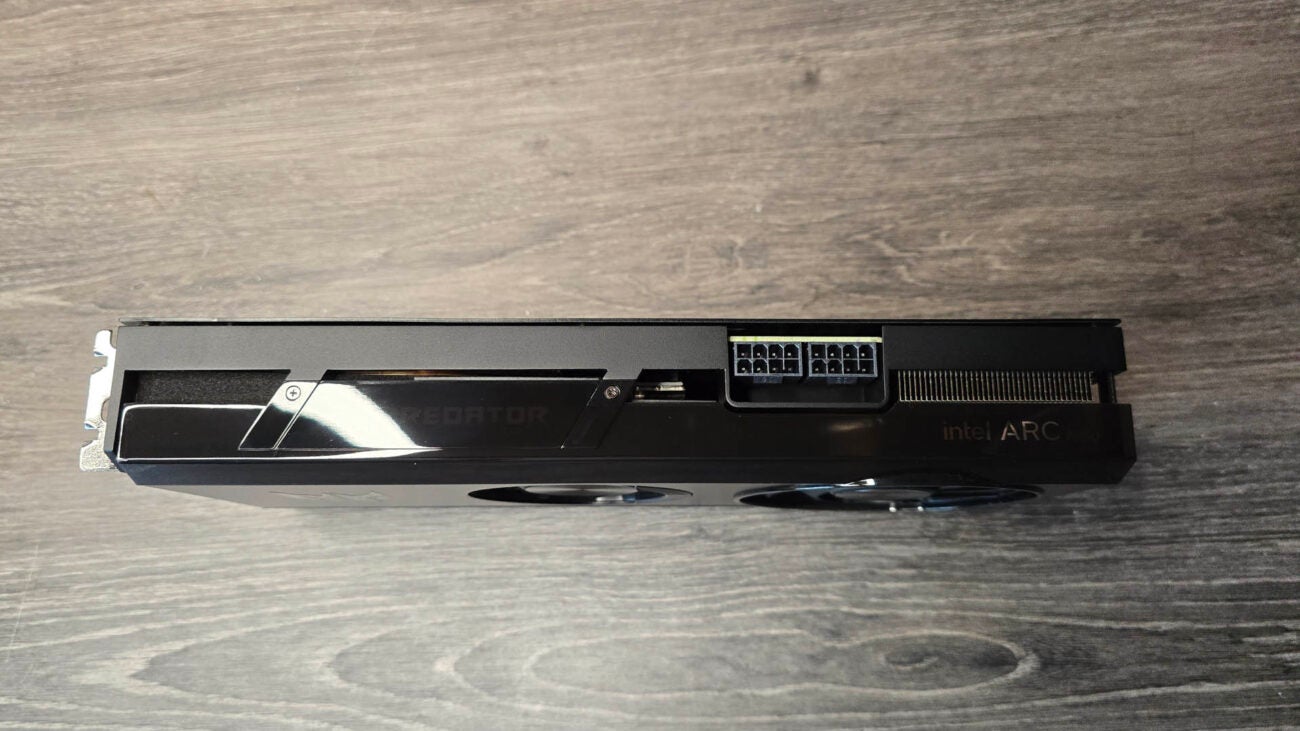
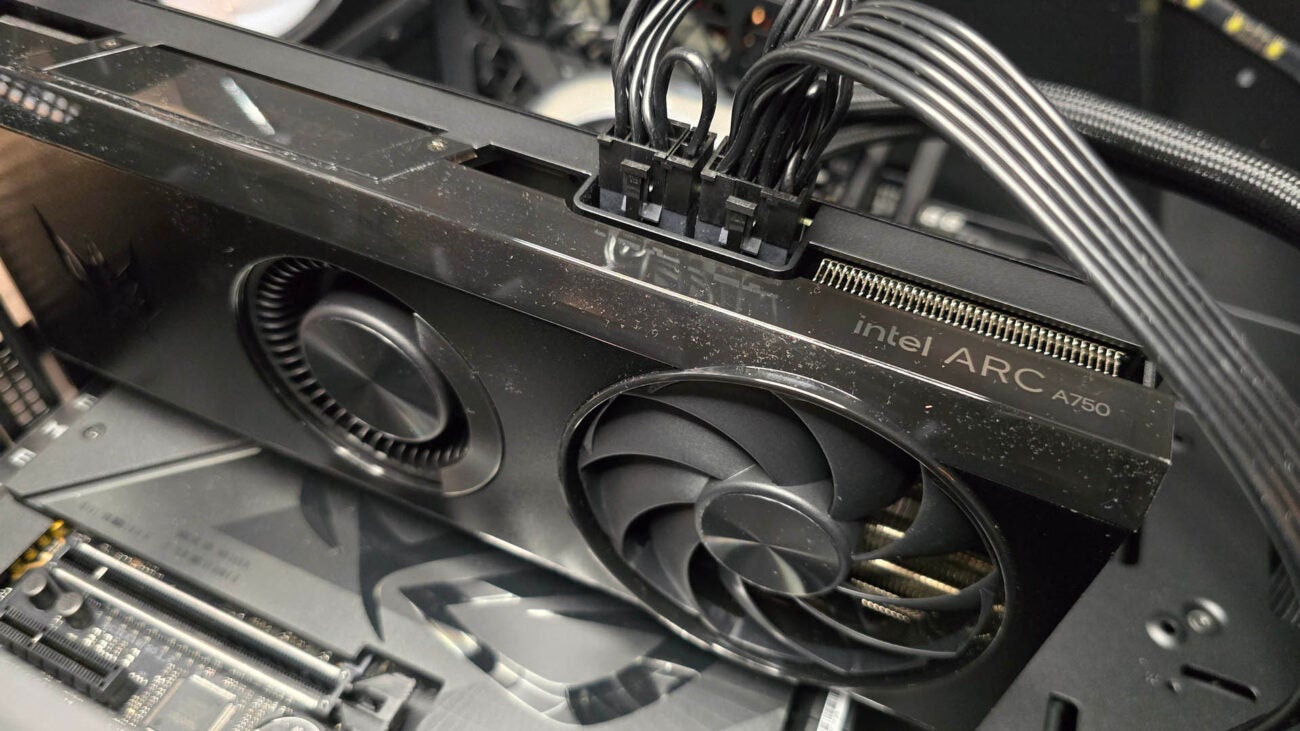


Verdict
It might not be the fastest GPU out there by any measure, but the Intel Arc A750 delivers incredible value for the money. You can easily pick one of these up for a low price right now. Across all of our test suites, at 1080p, it goes way over 60 fps under some serious load.
Pros
- Incredible value for money at 1080p
- Decent performance at 1440p too
- Acer card is super quiet
Cons
- 8GB VRAM will be limiting later on
- Card design could use work
Key Features
- Alchemist ArchitectureIntel’s utilizing its Alchemist architecture for the A750 which features a mix of traditional GPU hardware, alongside more modern Ray Tracing units as well.
- 8GB VRAMThe A750 houses 8GB of GDDR6 memory at its core, on a 256-bit bus, making it ideal for 1080p and 1440p gaming.
- Intel XeSSThanks to a whole armada of Tensor cores in the A750, Intel has developed its own form of AI upscaling, similar to DLSS, called XeSS.
Introduction
Intel’s Arc A750 is a phenomenal piece of engineering, and a fantastically affordable graphics card, ideal for 1080p gaming. It’s remarkable just how far Intel has come in such a short time frame, in what’s arguably one of the most difficult computing segments to break into. Arc, at the low end, is nothing if not impressive.
Utilizing TSMC’s N6 7nm manufacturing process, the GPUs feature a mix of traditional rasterization hardware, running alongside, dedicated Ray Tracing and Tensor hardware. This massively helps leverage modern graphics techniques, combined with AI sophisticated upscaling to deliver solid gaming performance across 1080p and 1440p.
Intel’s initial lineup includes three separate divisions of Arc GPUs, Arc 3, Arc 5, and Arc 7. The two most interesting cards of the lot, are the A750, which I’m reviewing here, (initially priced at $289), and the A770, (available in two variants, an 8GB and 16GB for $329 and $349 respectively).
Specs
- Alchemist architecture debuts with solid manufacturing process
- Pricing is insanely competitive
- VRAM could be a limiting factor later down the line
Unlike Nvidia and AMD, it’s quite challenging to analyze these cards from a purely hardware or spec perspective, as there’s no prior generation to compare it to, and the architecture is vastly different to the likes of Team Red and Green. The cards entirely live and die based on their relative performance to the competition.



Intel’s built out its Alchemist architecture to function as a modular chiplet design, rather than a monolithic style, similar to how AMD builds its top-tier GPUs. This gives Intel a slight edge, as it allows them to effectively scale up the card to any size and performance variable they want, without increasing complexity by any huge margin outside of power and temperature demands. It also makes it more cost-effective, and easier to manufacture as well, which is incredibly important, given how expensive GPU R&D is.
At its heart, the A750 features 28 Xe cores, comprised of 3,584 shading cores, 192 texture mapping units, 112 ROPs, and 28 ray tracing units. Those ray tracing units feature 896 Tensor cores, 448 execution units, and 7 render slices total, giving the A750 plenty of hardware for dedicated AI upscaling.
Intel also built the Arc Alchemist series on the back of the PCIe 4.0 connection interface as standard, and the A750 features 8GB of GDDR6 VRAM as well, all on a 256-bit bus, delivering 512 GB/s of total bandwidth. Considerably more bandwidth than the RX 7600, or its XT cousin. That’s perfect for 1080p in 2024, but if you’re looking to use this card in a few years time, or intend to game at 1440p, that 8GB of VRAM could end up being a significant bottleneck.
It’s the pricing that’s the real king here though, as Intel’s Arc A750 comes in at just shy of $210 at retail, making it one of the highest-performing affordable graphics cards out there right now. Is this the best graphics card money can buy? No, but it doesn’t need to be.
Test Setup
I’ve spent the last couple of weeks testing the Intel Arc A750 alongside a number of its competitors and counterparts, putting it through its paces across a mixture of real-world and synthetic benchmarks. With that in mind, I had to build a well-ventilated and solid test bed to get the most out of it, bearing in mind any potential bottlenecks. I took advantage of one of the best CPUs in the business to ensure that, the Core i9-14900K. You can find the full test bed specs below.
CPU: Intel Core i9-14900K
RAM: 32GB (2x16GB) Corsair Dominator Titanium @ 7200
Motherboard: ASUS ROG Maximus Z790 Dark Hero
CPU Cooler: Corsair iCUE Link H150i LCD 360mm AIO
Cooling: 8x Corsair iCUE Link QX120 120mm fans
PSU: 1200W Corsair RMx Shift 80+ Gold PSU
SSD: 2TB Gigabyte Aorus Gen5 12000 M.2 PCIe 5.0 SSD
Case: Geometric Future Model 8 Dharma
I’ve grabbed a ton of top-tier games and synthetic tests to put the A750 to the test, including benchmarks such as 3D Mark’s Fire Strike, Port Royal (for Ray Tracing), and Speedway. I’ve also tested these GPUs with Blender’s integrated benchmark too, all while keeping a keen eye on power draw, and peak temperatures throughout the benchmarking process.
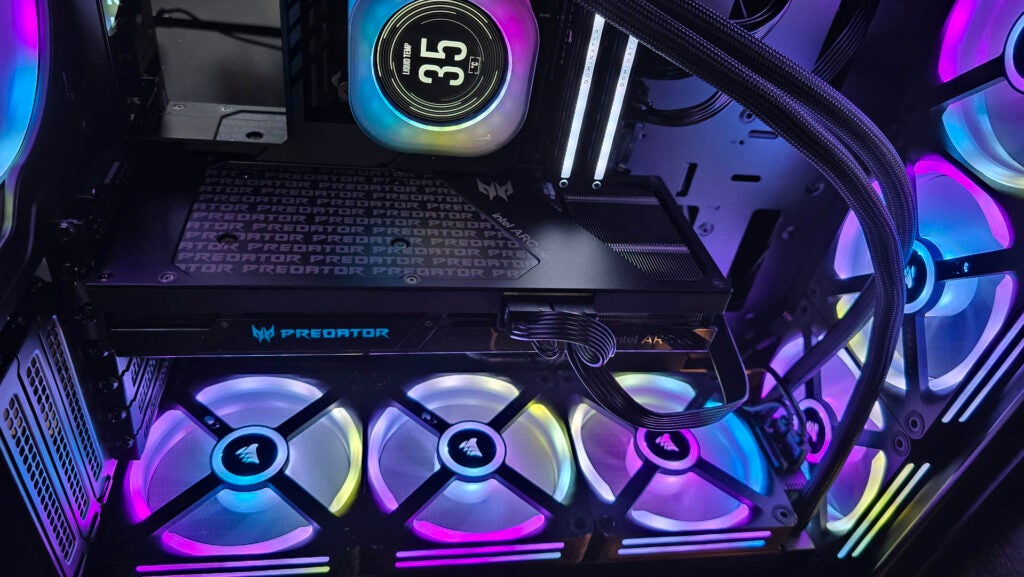
For our real-world gaming tests, we’ve gone for a total of seven titles here too, with standouts being Total War: Warhammer 3, Cyberpunk 2077 (with ray tracing enabled, and AI upscaling disabled), along with Red Dead Redemption II and Borderlands 3 as well.
In most of our tests, I’m using the Ultra or highest preset I can find to make the testing variables consistent across each run, however, in the titles that support ray tracing features (Cyberpunk and F1 2022), I’ve ensured DLSS, Intel XeSS, AMD FSR 2.0 or any form of AI upscaling is disabled by default.
Performance and Benchmarks
- Easily hits 50 fps in most titles
- Ray tracing does take its toll in certain games
- DX12 Compatibility could be problematic
Let’s cut to the chase, at 1080p the A750 is a serious contender. It regularly chugs away at 70-80 fps in almost all of our titles. There are a few exceptions to that, particularly Cyberpunk 2077 and F1 2022, with the latter hitting just 62 fps, and the former, 25. But both those games feature fairly aggressive ray tracing graphics options as standard, and with AI upscaling disabled the hit is seriously noticeable.
What’s particularly impressive about the Arc A750 is how it compares to the A770. In testing it was regularly within 5-10 fps of its far more expensive bigger brother. There wasn’t a whole lot in it, the A770 is certainly quicker sure, but not by much, and when you take into consideration the $140 price difference between the two, and the 8GB of extra VRAM the A770 has to its name, well it does leave you with questions.
One thing I would say, however, is that no matter what I tried, (clean install, driver re-install, different CPU), 3D Mark’s DX12 Speedway benchmark would crash on launch, occasionally making it 1-2 seconds into the benchmark before failing.
Ray Tracing and Upscaling
- Intel XeSS performance increase can be dramatic
- Not compatible with as many titles as DLSS
- Ray Tracing performance is decent at 1080p
I also tested the Arc A750 across several different ray tracing titles. This is purely a bit of a thought exercise to see how Intel’s XeSS compares against the likes of DLSS 3.0 and AMD’s FSR 2.0. In fact, at time of writing, Intel’s just dropped its XeSS 1.3 update as well, so numbers should improve here too.
All our ray tracing runs are completed at 4K, in four different configurations, with or without ray tracing enabled, and that, mixed with or without Intel XeSS as well. That gives us four sets of different results to draw on, and a ton of data to pour over.
So, how did the A750 do in such a taxing resolution? Well unsurprisingly, without XeSS it struggled. Cyberpunk 2077 in particular is brutal, with the GPU scoring 2 fps on average with ray tracing enabled, and XeSS disabled. Tick that XeSS box to yes though, and frame rates bounced up to 17 fps. Not that playable by any means, but still an incredible 750% bump in performance. This is likely due to XeSS alleviating a lot of the pressure from that 8GB VRAM buffer, in a more “normal” scenario, Shadow of the Tomb Raider, went from 25 to 33 fps with ray tracing on, with a more respectable 35% performance increase.
Power Consumption and Temperature
There’s no denying, that the Arc A750 is a hungry card. Across our time testing, the entire system pulled, at most, 604.3W from the wall, and idled at 195.1W. That’s on par with AMD’s RX 7800 XT, a far more powerful card, that nabbed 184.8W and 606.5W respectively, and is surprisingly more than even Nvidia’s RTX 4070 Super, at 172.3W and 589.3W too.
Temperatures however remained well tamed throughout the benchmarking process, and peak GPU temp never went above 84.0C. That’s not the coolest we’ve seen, again with the RTX 4080 Super from Asus staying well below that with a max temp of 74.5 C (and that’s on its hot spot, not the GPU, which hit just 65.0C) but it’s well within reasonable GPU temp parameters.
Latest deals
Should you buy it?
You want the best value 1080p gaming GPU
The Intel Arc A750, no matter its flavour, is an incredibly impressive graphics card. Although its average frame rates do lack the impact of some of the heavier hitters from the competition, Intel’s nailed the pricing on the A750 by some margin, and per $ it’s the best value GPU out there right now.
You’re looking for a GPU for the future
8GB of VRAM for 1080p gaming, is more than enough. That said, if you’re looking to upgrade monitors in the future, or are planning on gaming at 1440p with this thing, you might want to opt for something with a touch more VRAM instead, like the Arc A770 or AMD’s RX 7600 XT.
Final Thoughts
The Intel Arc A750 marks a curious first launch from Intel but the positive results speak for themselves. It’s not by a top-tier card, and its MSRP represents that. It’s had significant price cuts since its launch and is now available at such a low price, that’s made it a phenomenally tantalizing 1080p proposition that is set to fill out the budget position in our best graphics card guide.
The 8GB VRAM is a little limiting however, so if you do plan on gaming at 1440p, just know that later down the line, you’ll probably need something with a bit more VRAM and a bit more power. Nvidia’s GeForce RTX 4070 Super, and AMD’s RX 7800 XT are fantastic picks in that regard.
Still, for a first attempt, the Arc A750 is impressive, and although Acer’s cooler lacks the aesthetic panache of some of the competition out there, its unique cooler design keeps the card well-chilled and reasonably quiet regardless of what you throw at it.
How we test
Each of the graphics cards we test is installed into a dedicated test bed. After which, multiple different benchmarks are run to stress test the card, at a variety of different resolutions. We also monitor power draw and temperature throughout this procedure.
Tested in a dedicated gaming PC
power draw and temperatures monitored
Gaming benchmarks used
FAQs
Yes, the Intel Arc A750 performs incredibly well averaging 74.14 fps across our entire test suite. At this price point it’s a really strong contender.






